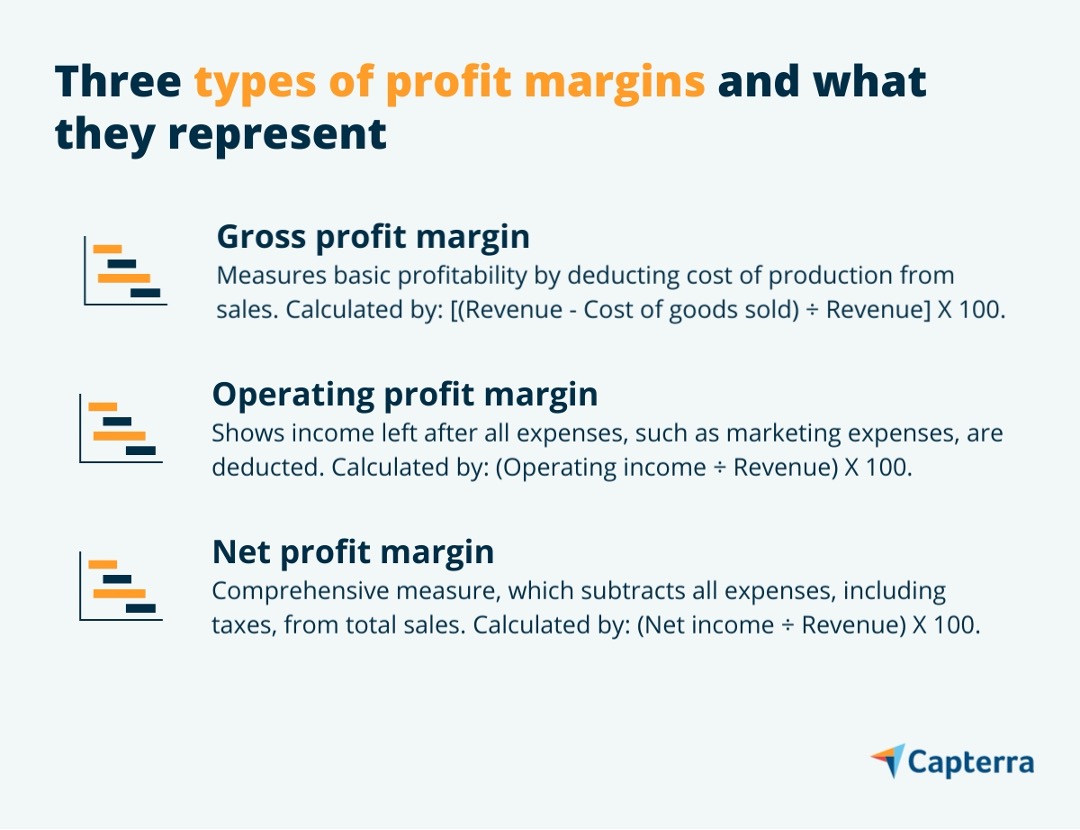Learn all you need to know about profit margins and compare your current margins against industry standards.
It can be difficult for small-business owners to determine what level of profitability will make their venture both sustainable and successful. Finding this 'sweet spot' requires careful calculation. You'll need to understand your costs and revenue in relation to industry standards so that you can not only have a good margin but also be competitive.
A profit margin of less than 7% may imply operating at a loss, and margins over 20% indicate highly profitable operations, says Lantern Partners founder and chief financial officer (CFO) Michelle Kvello[1], who helps startups and small and midsize businesses (SMBs) scale up and grow.
With the help of business consultants and valuation experts[1][2][4], we put together this guide for startups and SMBs seeking a benchmark to weigh in their business profits and looking to understand if they are doing well in comparison to their peers.
Get an overview of all the essentials you need to understand your profit margins and learn what margins you should aim for.
As a small business owner, if your profit margin is lower than typical in your industry, it typically means your sales are too low or your costs are too high, and looking at the reasons why will help you find opportunities to improve your business.


Keiran James
Registered business valuer
What is a profit margin?
Profit margin is how much financial gain you make on a product or service. It’s the profit from a sale after deducting routine production costs and other expenses. It measures a business’s profitability and its ability to generate income.
It is calculated in percentage. To do that, take all your revenue earned from selling goods and services and subtract what it costs to produce them, then divide by total revenue and multiply by 100. A basic profit margin formula can be given by:
Profit margin = [(Revenue - Cost) / Revenue] X 100
In practice, however, rather than relying solely on one profit margin percentage, various types of profit margins are used to measure different aspects of profitability and calculate the overall company efficiency. The three primarily used profit margins are discussed below. We’ve also created a free profit margins calculator so you can easily start figuring out the numbers!
So, why is it important for small businesses to learn about profit margins?
The profit margin is ultimately what will keep your business running. Financially, how much money you make in profit margin indicates whether a business will do well, average, or poor. More specifically, you can use profit margin to:
Make informed pricing decisions.
Understand costs and determine where to cut back to boost the bottom line.
Track progress and ensure the sustainability of the business.
Decide where to reinvest the income for further growth.
Fundamentally, small businesses need to know their margins to know they have built a sustainable business. Whether you’re a service or a product business, knowing how much it costs to generate each incremental $1 of revenue is essential. Shooting for the ideal range will also tell you the volume of sales you need to cover your overheads and have a positive net margin.


Michelle Kvello
Founder and CFO at Lantern Partners
What do you need to determine how profitable your venture can be? Here are a few essentials you need to know before you arrive at your optimal profit margin values. We’ve also provided a convenient downloadable calculator that breaks down your costs and helps you calculate your current margins.
Four things to know to reach a good profit margin
Be sure to examine four aspects before determining a good profit margin for your business.
1. Setting profitability goals based on industry
The ideal margin for a business can be tricky to determine. There is no one-size-fits-all answer to the question of what a good profit margin for a small business is, as it’s highly driven by external factors, such as:
The industry you operate within
The type and level of competition you face
For example, companies in the retail industry typically have lower profit margins than companies in the technology industry. Similarly, if you have strong competitors, you would set a slightly lower profit margin to stay competitive. On the other hand, if there’s little-to-no competition, you would take more risks and set a slightly higher margin rate.
Based on interviews with profit specialists and surveys, we’ve collated a table for healthy profit margins by industry.
While a good profit margin target depends on the business’s industry, generally speaking, a profit margin of 7% to 10% or higher is considered healthy, says Kvello.
2. Understanding different types of profit margins and their benefits
Three key profit margins, all measuring different aspects of profitability, can provide a clear picture:
Gross profit margin will help you understand how efficiently you are using your production resources.
Operating profit margin will help you identify areas where expenses in overall business operations can be reduced to improve efficiency.
Finally, the net profit margin is the most comprehensive measure of profitability that shows your overall profits or losses resulting from total sales after considering the effect of interest payments and tax outflows.

All three margins are mentioned in the income statement of a business and can be used to determine if a product or service is worth pursuing and assess the overall financial health.
To determine your current profit margins, download our free margin calculator.
3. Analyzing direct costs and indirect costs to improve profitability
Costs are an essential element in understanding profit margin. Direct costs are those directly associated with producing a product or providing a service, such as labor, materials, and supplies, among other things that contribute to building your offerings.
Indirect expenses are more general overheads that don't have a clear link to production but are still related to running the business, such as telephone bills, rent, insurance premiums, marketing, and utilities.
A thorough analysis of these two costs can help you identify areas where money is wasted and suggest ways to reduce expenditure and increase the efficiency of operations.
4. Balancing short-term vs. long-term profit expectations
Profit margins usually have a deeper meaning than it seems. Maximizing profits is not just about reducing costs but making smart business investments as well.
This means not cutting your costs blindly. Business owners should adopt a holistic perspective when evaluating their expenditures for greater returns. Consider present and potential future gains. For example, keeping aside financial cushion for mid-term projects or initiatives can ensure positive long-term gains down the line!
/ Pro tip
Carefully monitoring your cash-flow patterns can be incredibly beneficial to make well-informed investment decisions. Savvy organizations use modern tools such as budget tracking software to make sure they are investing enough resources in profitable product or service units and get the most out of their money over time.
Benchmark your profit margin based on industry averages
Benchmarking the average figures of various industries will help you get an idea of how much profit can be achieved. Analyze and set a realistic target for profit margin improvement with these insights on key market segments.
For example, the gross profit margin for most retail businesses is approximately 20%, while for software, it’s nearly 75% (see the table below). The reason margins vary by industry is that each one has different operating costs. For example, manufacturing businesses have to invest in machinery, equipment, and raw materials, while service businesses have to pay for labor and overhead costs. Retail businesses have to account for inventory and other costs to cover overheads. Ultimately, the goal is to generate enough revenue to cover all of your costs. The key is to find the right balance for your specific business and industry.
Average profit margins, by industry
Industry | Gross margin | Net margin |
|---|---|---|
Advertising | 26% | 3% |
Auto & truck | 14% | 4% |
Auto parts | 16% | 1% |
Beverage (Alcoholic) | 48% | 5% |
Beverage (Soft) | 55% | 14% |
Building materials | 28% | 8% |
Business & consumer services | 32% | 5% |
Computer services | 27% | 3% |
Computers/Peripherals | 37% | 19% |
Construction supplies | 23% | 8% |
Drugs (Pharmaceutical) | 67% | 11% |
Education | 48% | 7% |
Electronics (Consumer & office) | 32% | 7% |
Electronics (General) | 28% | 7% |
Engineering/Construction | 13% | 2% |
Food processing | 27% | 8% |
Food wholesalers | 15% | 1% |
Home furnishings | 30% | 8% |
Healthcare products | 59% | 13% |
Healthcare support services | 15% | 2% |
Healthcare information & technology | 52% | 17% |
Homebuilding | 25% | 13% |
Machinery | 25% | 11% |
Office equipment & services | 33% | 3% |
Packaging & container | 22% | 6% |
Paper/Forest products | 30% | 12% |
Publishing & newspaper | 43% | 4% |
Restaurant/Dining | 32% | 13% |
Retail (Automotive) | 22% | 5% |
Retail (Building supply) | 35% | 10% |
Retail (Distributors) | 30% | 5% |
Retail (General) | 24% | 3% |
Retail (Grocery & food) | 26% | 1% |
Retail (Online) | 42% | 7% |
Software (System & application) | 72% | 20% |
Telecom (Wireless) | 57% | 5% |
Telecom (Equipment) | 56% | 15% |
Telecom (Services) | 55% | 8% |
Transportation | 21% | 6% |
Trucking | 25% | 2% |
The ideal net profit margin for the restaurant industry could be anywhere up to 15%, although that number is rarely ever achieved by small businesses. Most restaurant profit margins are low at about 5% or less. This is due to the increasing costs of supply chain food services, business maintenance, permit renewals, employee training, and the list goes on. Needless to say, there’s a lot going on behind the scenes of running a food business.


Brian Nagele
CEO, Restaurant Clicks
/ Pro tip
Another good way to determine the optimal profit margin is to ask your industry association. Most industry associations will be able to provide you with ballpark figures that are typically quite accurate.
Capterra tools and tips to help you grow profit margins over time:
Most often, poor margins are a result of improper accounting and access to data. Employing innovative technology can increase efficiency in operations. Here are some tools and strategies to increase your bottom line.
Track profit margins for individual products and services. Don’t simply batch overall revenue against the cost of goods sold. Instead, dive deeper into each product or service’s individual gross profit margin for greater insight into the highest yields. If you’ve multiple revenue streams from different products, you may often find that one is losing money. Looking only at the overall profit margin can hide the product making you incur a loss. Dig deeper to calculate gross profit margin for different product and service lines to find your most profitable areas.
Integrate core accounting systems with expense or spend management software. It offers an efficient way to gain insight into employee-initiated and procurement-related costs while promoting better visibility without manual entries. You’ll be able to monitor spending in real time, identify cost-saving opportunities, limit overspending, and ensure budget compliance.
Optimize your pricing tier carefully. Through data-driven decisions, businesses can find the perfect balance between profit-maximizing prices and attracting new customers. Use price optimization tools to determine the most profitable selling price points. Alternatively, leverage revenue management software to adjust pricing based on time, season, location, and competition.
Monitor profit margins down to invoice level with business intelligence tools. Intuitive, easy-to-use BI software will help you shift your focus from minimizing costs toward broadening overall profits. For example, use it to incentivize sales staff with rewards based on their margin levels, not just the traditional metric of sales volume.
Take control of your business’s profitability with our profit margin calculator. Identify where you’re making and losing money and make informed decisions. And best of all, it’s easy to use, fully customizable based on your specific needs, and free!

